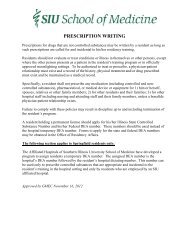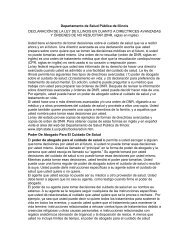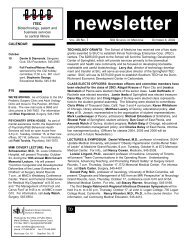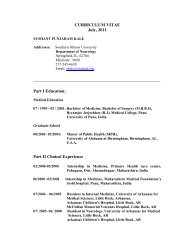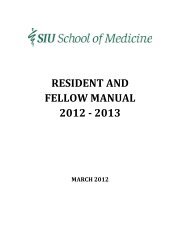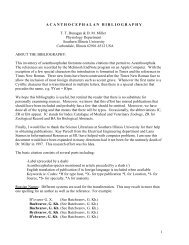Ch. 54 – Biliary System
Ch. 54 – Biliary System
Ch. 54 – Biliary System
Create successful ePaper yourself
Turn your PDF publications into a flip-book with our unique Google optimized e-Paper software.
Figure <strong>54</strong>-35 Bismuth classifi cation of perihilar cholangiocarcinoma<br />
by anatomic extent. Type I tumors (upper, left) are confi<br />
ned to the common hepatic duct, and type II tumors (upper,<br />
right) involve the bifurcation without involvement of secondary<br />
intrahepatic ducts. Type IIIa and IIIb tumors (lower, left) extend<br />
into either the right or left secondary intrahepatic ducts, respectively.<br />
Type IV tumors (lower, right) involve the secondary intrahepatic<br />
ducts on both sides.<br />
cinoma between 11 and 18 years after a biliary-enteric<br />
anastomosis. The risk for bile duct cancer was higher<br />
after transduodenal sphincteroplasty and choledochoduodenostomy<br />
than after hepaticojejunostomy and was<br />
most strongly associated with recurrent episodes of cholangitis.<br />
Multiple other risk factors for cholangiocarcinoma<br />
have been identifi ed, including liver fl ukes, Thorotrast,<br />
industrial chemicals, dietary nitrosamines, and exposure<br />
to dioxin.<br />
Staging and Classifi cation<br />
<strong>Ch</strong>olangiocarcinoma is best classifi ed anatomically into<br />
three broad groups:<br />
1. Intrahepatic<br />
2. Perihilar<br />
3. Distal<br />
Intrahepatic tumors are treated like hepatocellular<br />
carcinoma with hepatectomy, when possible. The<br />
perihilar tumors make up the largest group and are<br />
managed with resection of the bile duct, preferably<br />
with hepatic resection. Distal tumors are managed in a<br />
fashion similar to other periampullary malignancies with<br />
pancreatoduodenectomy.<br />
Cancers of the hepatic duct bifurcation have also been<br />
classifi ed according to their anatomic location (Fig.<br />
<strong>54</strong>-35). In this system, type I tumors are confi ned to the<br />
common hepatic duct, and type II tumors involve the<br />
bifurcation without involvement of secondary intrahe-<br />
<strong>Ch</strong>apter <strong>54</strong> <strong>Biliary</strong> <strong>System</strong> 1583<br />
Table <strong>54</strong>-3 Current American Joint Commission on Cancer<br />
TNM Staging <strong>System</strong> for <strong>Ch</strong>olangiocarcinoma<br />
Stage 0 Tis N0 M0<br />
Stage I T1 N0 M0<br />
Stage II T2 N0 M0<br />
Stage III T1 or T2 N1 or N2 M0<br />
Stage IVA T3 Any N M0<br />
Stage IVB Any T Any N M1<br />
Tis, carcinoma in situ; T1, tumor invades the subepithelial connective<br />
tissue; T2, tumor invades perifi bromuscular connective tissue; T3, tumor<br />
invades adjacent organs.<br />
N0, no regional lymph node metastases; N1, metastasis to<br />
hepatoduodenal ligament lymph nodes; N2, metastasis to peripancreatic,<br />
periduodenal, periportal, celiac, and/or superior mesenteric artery lymph<br />
nodes.<br />
M0, no distant metastasis; M1, distant metastasis.<br />
Adapted from Greene F, Page D, Fleming I, et al (eds): AJCC Cancer<br />
Staging Manual, 6th ed. New York, Springer-Verlag, 2002.<br />
patic ducts. Types IIIa and IIIb tumors extend into either<br />
the right or left secondary intrahepatic ducts, respectively,<br />
and type IV tumors involve the secondary intrahepatic<br />
ducts on both sides.<br />
<strong>Ch</strong>olangiocarcinoma is also staged according to the<br />
tumor, node, metastasis (TNM) classifi cation of the AJCC<br />
(Table <strong>54</strong>-3). Using this system, stage IA tumors are<br />
limited to the bile duct, whereas stage IB tumors invade<br />
periductal tissues. Stage IIA tumors are locally advanced<br />
without lymph node metastases, and stage IIB tumors<br />
have regional lymph node metastases. Stage III tumors<br />
are locally advanced and unresectable, and stage IV<br />
tumors have distant metastases. Portal vein involvement<br />
and lobar atrophy have been reported as important prognostic<br />
factors for cholangiocarcinoma and may be incorporated<br />
in the classifi cation in the future. 45<br />
Clinical Presentation<br />
More than 90% of patients with perihilar or distal tumors<br />
present with jaundice. Patients with intrahepatic cholangiocarcinoma<br />
are rarely jaundiced until late in the course<br />
of the disease. Less common presenting clinical features<br />
include pruritus, fever, mild abdominal pain, fatigue,<br />
anorexia, and weight loss. <strong>Ch</strong>olangitis is not a frequent<br />
presenting fi nding but most commonly develops after<br />
biliary manipulation. Except for jaundice, the physical<br />
examination is usually normal in patients with<br />
cholangiocarcinoma.<br />
Diagnosis and Assessment of Resectability<br />
At the time of presentation, most patients with perihilar<br />
and distal cholangiocarcinoma have a total serum bilirubin<br />
level greater than 10 mg/dL. Marked elevations in<br />
alkaline phosphatase are also routinely observed. Serum<br />
CA 19-9 may also be elevated in patients with cholangiocarcinoma,<br />
although levels may fall once biliary obstruction<br />
is relieved.<br />
The radiologic evaluation of patients with cholangiocarcinoma<br />
should delineate the overall extent of the



